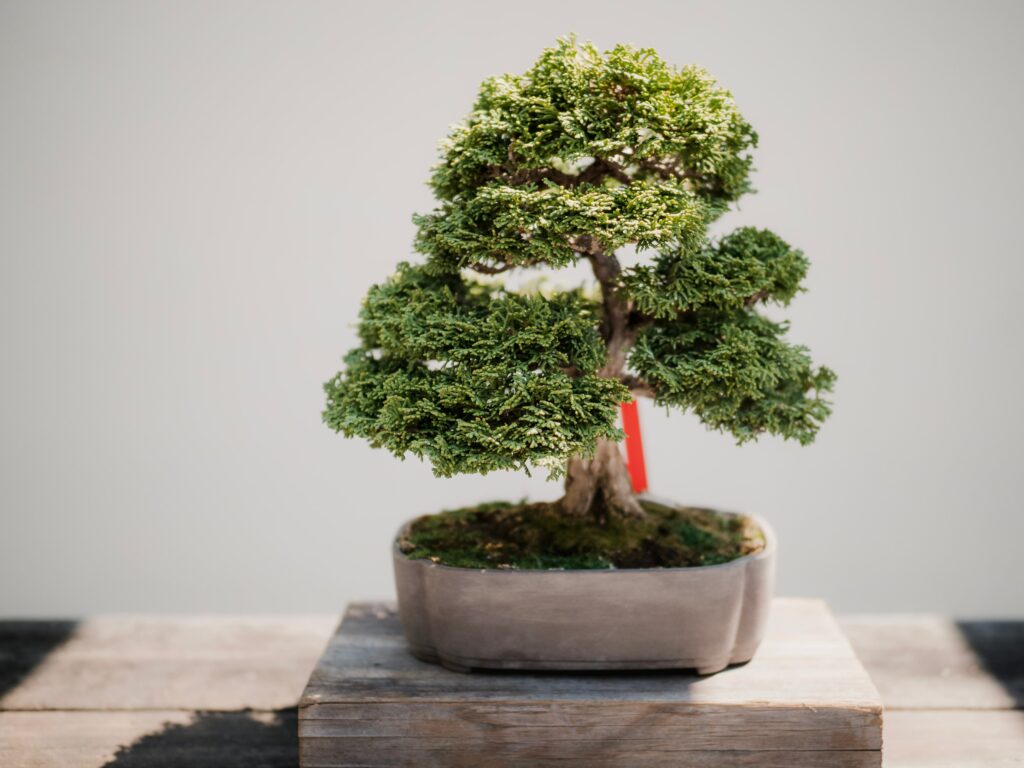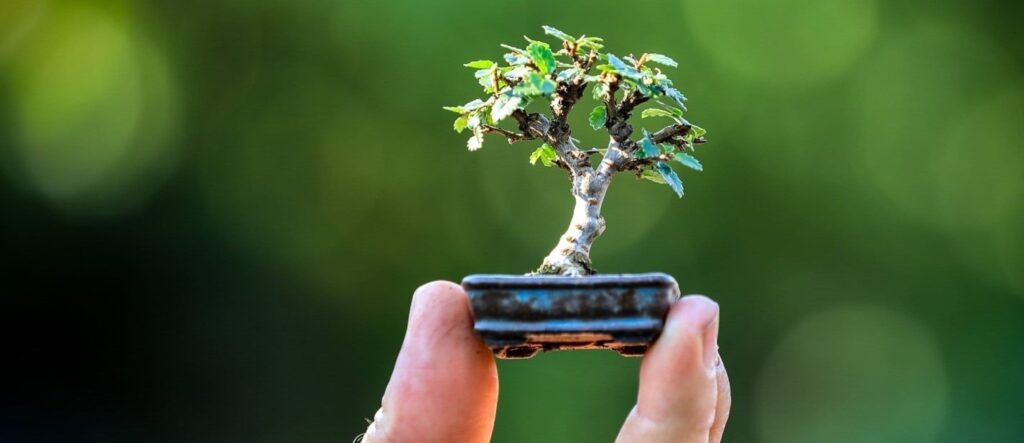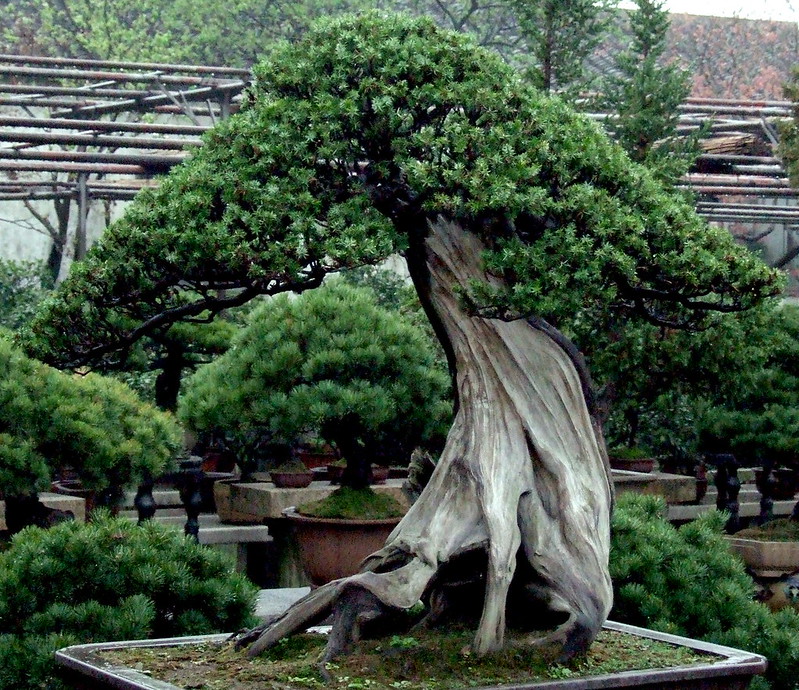Bonsai trees are a beautiful and unique way to bring some nature indoors. Not only do they look great in any living space, but they are also a fun and rewarding hobby for any gardening enthusiast. And with the correct care and depending on the species, a bonsai tree can live for tens, if not hundreds, of years.
But what exactly are bonsai trees, how long does it take to grow them, and how long do they live? We’ll cover all of that in this article!

Bonsai trees – what are they?
Bonsai trees – just like the Japanese Red Maple – have been a part of Japanese culture for centuries. But did you know they originated in China? Now those small trees are appreciated by plant enthusiasts across the globe. And deservingly so!
But what exactly are bonsai trees? To put it simply, they are smaller versions of trees grown in the wild. Bonsai trees are grown in containers and are pruned and trained to produce an aesthetically pleasing, miniature version of a full-sized tree. As essentially any tree can be cultivated into a bonsai, there are numerous different bonsai tree species.
How long does it take a Bonsai tree to grow?
As bonsai trees are typically grown for aesthetic purposes, the growth time depends on the care and attention it receives from their owner. A bonsai tree can be shaped and grown according to the owner’s desired design with regular pruning and watering.
The growth rate can vary depending on the climate and environment of the tree. For example, the tree may grow faster in a warmer environment than in a colder one. And different types of bonsais grow at different rates. The only way to make your bonsai grow faster is to provide it with its preferred living conditions. However, patience is needed when it comes to those plants – it generally takes 10 to 15 years for a bonsai to reach its full size.
How big do Bonsai trees get?
Well, that is virtually up to you! Bonsais can be as small as a few inches or grow as big as 80 inches. Most of those cultivated trees are between 10 and 20 inches.
So, how big do bonsai trees get usually? Bonsai trees are known for their small sizes. However, they do grow larger over time – some faster than others. For example, jade and wisteria bonsais grow slowly, around 2 to 5 inches per year. Chinese elm and ficus can grow 12 to 36 inches annually.
However big or small you’d like your tree to be is up to you. If you don’t have much space and want to keep your bonsai on a smaller scale, ensure you prune it regularly. Trim the leaves, branches, and roots as the tree grows.
Want a big statement piece instead? Maintain optimal living conditions for your plant. Re-pot it as it grows to allow the roots enough room to expand. Don’t forget to prune the tree to allow new healthy growth. You also want to take precautions to avoid any infections and pests. And be patient! It takes years for a small bonsai to grow into a medium-sized tree. And tens of years to reach a large size.
The biggest Bonsai tree in the world – which is also one of the oldest – is called Red Pine. The more than 30 feet wide and 16 feet tall tree is located in Akao Herb and Rose Garden in japan.
Size classifications of Bonsai trees
As mentioned above, the sizes of bonsai trees can vary a lot. That is why they are classified into different categories according to their size. There are ten categories – the following list is from smallest to biggest.

- Keshitsubo – 1 to 3 inches
- Shito – 2 to 4 inches
- Mame – 2 to 6 inches
- Chohin – 5 to 8 inches
- Kumono – 6 to 10 inches
- Katade-mochi – 10 to 18 inches
- Chiu or Chumono – 16 to 36 inches
- Dai or Omono – 30 to 48 inches
- Hachi-uye – 40 to 60 inches
- Imperial – 60 to 80 inches
Here is an interesting fact! The sizes of bonsais were originally classified by the number of hands it would take to move the tree. So, imperial trees that grow up to 80 inches are called eight-handed bonsais.
The oldest bonsai tree in the World
The durability and strength of nature are remarkable, and we’ve all heard of, if not seen, trees that have been alive for hundreds of years. However, wild trees in mother nature tend to live much longer than those grown in pots that depend on the care received by humans. That is why the old age of some bonsai trees is so impressive!
Some of the oldest bonsai trees are ficus bonsai at Crespi, Italy, a juniper bonsai tree in the Mansei-En bonsai nursery, and another juniper in Omiya bonsai village. How old is the oldest bonsai tree exactly? It is hard to tell, however, as all of them are older than a thousand years!

How long do Bonsai trees live?
While there are a couple of bonsai trees older than a thousand years, reaching that age is an exception rather than a rule. So how long do those pieces of art generally live?
There is no one fits all answer to that question. The longevity of your bonsai depends on several factors. The first thing you want to think about is the species of tree you’re growing. For example, junipers usually live for around 50 years, but some can even live up to 100 years, and it is not rare for cypress bonsai trees to live for centuries. Pine trees have a naturally long lifespan – with the right care, a pine bonsai can live up to a few hundred years. Ficus bonsai trees have a similarly long lifespan.
At the end of the day, the lifespan of your bonsai will come down to its environment and the care you provide it. If you’re growing the right tree in its optimal environment and take good care of it, your bonsai will easily live for tens, if not a few hundred years.
